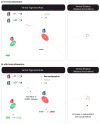Hooked on benzodiazepines: GABAA receptor subtypes and addiction
- PMID: 21353710
- PMCID: PMC4020178
- DOI: 10.1016/j.tins.2011.01.004
Hooked on benzodiazepines: GABAA receptor subtypes and addiction
Abstract
Benzodiazepines are widely used clinically to treat anxiety and insomnia. They also induce muscle relaxation, control epileptic seizures, and can produce amnesia. Moreover, benzodiazepines are often abused after chronic clinical treatment and also for recreational purposes. Within weeks, tolerance to the pharmacological effects can develop as a sign of dependence. In vulnerable individuals with compulsive drug use, addiction will be diagnosed. Here we review recent observations from animal models regarding the cellular and molecular basis that might underlie the addictive properties of benzodiazepines. These data reveal how benzodiazepines, acting through specific GABA(A) receptor subtypes, activate midbrain dopamine neurons, and how this could hijack the mesolimbic reward system. Such findings have important implications for the future design of benzodiazepines with reduced or even absent addiction liability.
Copyright © 2011 Elsevier Ltd. All rights reserved.
Figures



Similar articles
-
Neural bases for addictive properties of benzodiazepines.Nature. 2010 Feb 11;463(7282):769-74. doi: 10.1038/nature08758. Nature. 2010. PMID: 20148031 Free PMC article.
-
Is there a way to curb benzodiazepine addiction?Swiss Med Wkly. 2011 Oct 19;141:w13277. doi: 10.4414/smw.2011.13277. eCollection 2011. Swiss Med Wkly. 2011. PMID: 22012428 Review.
-
Contributions of GABAA receptor subtype selectivity to abuse liability and dependence potential of pharmacological treatments for anxiety and sleep disorders.CNS Spectr. 2005 Jan;10(1):31-9. doi: 10.1017/s1092852900009883. CNS Spectr. 2005. PMID: 15618945 Review.
-
Neuroscience: Lack of inhibition leads to abuse.Nature. 2010 Feb 11;463(7282):743-4. doi: 10.1038/463743a. Nature. 2010. PMID: 20148025 Free PMC article.
-
Selective antagonism of GABAA receptor subtypes: an in vivo approach to exploring the therapeutic and side effects of benzodiazepine-type drugs.CNS Spectr. 2005 Jan;10(1):40-8. doi: 10.1017/s1092852900009895. CNS Spectr. 2005. PMID: 15618946 Review.
Cited by
-
Reducing Allostatic Load in Depression and Anxiety Disorders: Physical Activity and Yoga Practice as Add-On Therapies.Front Psychiatry. 2020 Jun 4;11:501. doi: 10.3389/fpsyt.2020.00501. eCollection 2020. Front Psychiatry. 2020. PMID: 32581876 Free PMC article. Review.
-
Benzodiazepine Modulation of GABAA Receptors: A Mechanistic Perspective.Biomolecules. 2022 Nov 30;12(12):1784. doi: 10.3390/biom12121784. Biomolecules. 2022. PMID: 36551212 Free PMC article. Review.
-
Quercetin Antagonizes the Sedative Effects of Linalool, Possibly through the GABAergic Interaction Pathway.Molecules. 2023 Jul 24;28(14):5616. doi: 10.3390/molecules28145616. Molecules. 2023. PMID: 37513487 Free PMC article.
-
Paper-Based Electrochemical Devices for the Pharmaceutical Field: State of the Art and Perspectives.Front Bioeng Biotechnol. 2020 Apr 23;8:339. doi: 10.3389/fbioe.2020.00339. eCollection 2020. Front Bioeng Biotechnol. 2020. PMID: 32391344 Free PMC article. Review.
-
Valium without dependence? Individual GABAA receptor subtype contribution toward benzodiazepine addiction, tolerance, and therapeutic effects.Neuropsychiatr Dis Treat. 2018 May 23;14:1351-1361. doi: 10.2147/NDT.S164307. eCollection 2018. Neuropsychiatr Dis Treat. 2018. PMID: 29872302 Free PMC article. Review.
References
-
- Salzman C. Addiction to benzodiazepines. Psy Quart. 1998;69:251–261. - PubMed
-
- Schull P. Nursing Spectrum Drug Handbook. McGraw Hill; 2009.
-
- Sternbach LH. The benzodiazepine story. J Psychoact drugs. 1983;15:15–17. - PubMed
-
- Woods JH, et al. Benzodiazepines: use, abuse, and consequences. Pharmacol Rev. 1992;44:151–347. - PubMed
-
- Schultz W, et al. A neural substrate of prediction and reward. Science. 1997;275:1593–1599. - PubMed
Publication types
MeSH terms
Substances
Grants and funding
LinkOut - more resources
Full Text Sources
Other Literature Sources
Medical
Molecular Biology Databases

